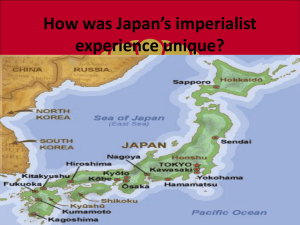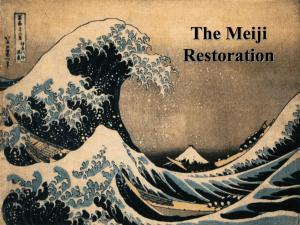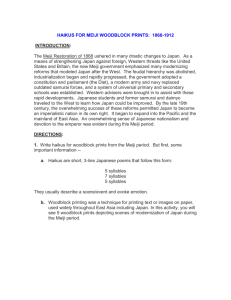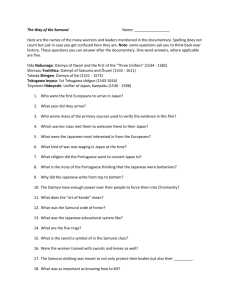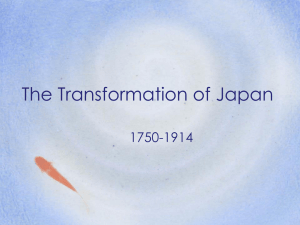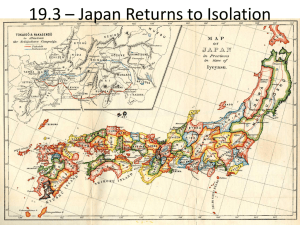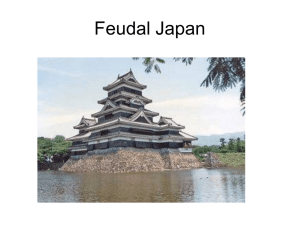Tokugawa Period's Influence on Meiji Restoration
advertisement
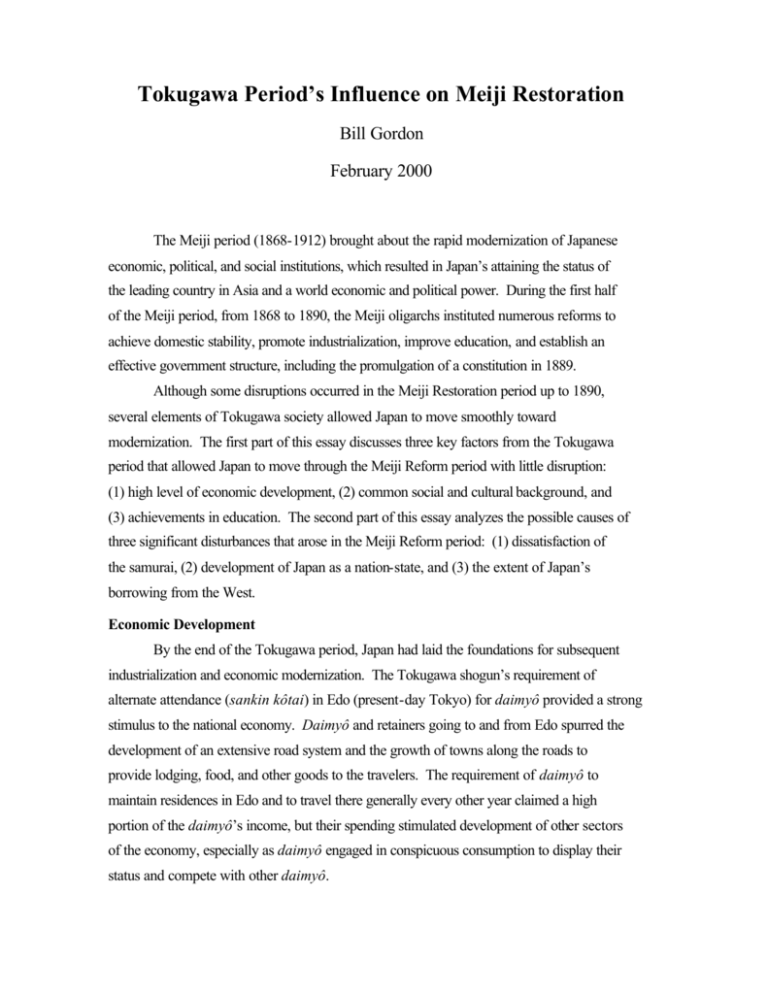
Tokugawa Period’s Influence on Meiji Restoration Bill Gordon February 2000 The Meiji period (1868-1912) brought about the rapid modernization of Japanese economic, political, and social institutions, which resulted in Japan’s attaining the status of the leading country in Asia and a world economic and political power. During the first half of the Meiji period, from 1868 to 1890, the Meiji oligarchs instituted numerous reforms to achieve domestic stability, promote industrialization, improve education, and establish an effective government structure, including the promulgation of a constitution in 1889. Although some disruptions occurred in the Meiji Restoration period up to 1890, several elements of Tokugawa society allowed Japan to move smoothly toward modernization. The first part of this essay discusses three key factors from the Tokugawa period that allowed Japan to move through the Meiji Reform period with little disruption: (1) high level of economic development, (2) common social and cultural background, and (3) achievements in education. The second part of this essay analyzes the possible causes of three significant disturbances that arose in the Meiji Reform period: (1) dissatisfaction of the samurai, (2) development of Japan as a nation-state, and (3) the extent of Japan’s borrowing from the West. Economic Development By the end of the Tokugawa period, Japan had laid the foundations for subsequent industrialization and economic modernization. The Tokugawa shogun’s requirement of alternate attendance (sankin kôtai) in Edo (present-day Tokyo) for daimyô provided a strong stimulus to the national economy. Daimyô and retainers going to and from Edo spurred the development of an extensive road system and the growth of towns along the roads to provide lodging, food, and other goods to the travelers. The requirement of daimyô to maintain residences in Edo and to travel there generally every other year claimed a high portion of the daimyô’s income, but their spending stimulated development of other sectors of the economy, especially as daimyô engaged in conspicuous consumption to display their status and compete with other daimyô. 2 Urbanization proceeded steadily during the Tokugawa period. The capital Edo developed into a great urban center with over one million inhabitants by 1720. Many towns where daimyô had castles (e.g., Osaka, Hiroshima, Nagoya, Kanazawa) developed into large cities. Osaka became a leading trading and financial center. This urbanization during the Tokugawa period provided the basis for a unified national economy, stimulated demand for agricultural and other goods produced in rural areas, and led to an urban-centered commercial economy. This growth of cities during the Tokugawa period provided a firm foundation for Japan’s modernization during the Meiji period. Commodity and financial markets grew to meet the consumption demands of daimyô and the samurai class. During the Tokugawa period, peasants made the transition from subsistence farming to cultivation of commercial crops for sale in markets. Town industries, such as textile weaving and sake brewing, developed as markets for the towns’ products increased, which served as the foundation for the subsequent rapid growth of various industries during the Meiji period. Great family enterprises, such as Mitsui, Sumitomo, and Kônoike, expanded their operations during the Tokugawa period into various businesses, including banking facilities that provided loans to daimyô and samurai. These enterprises served as forerunners to the zaibatsu (huge industrial and financial conglomerates), which were formed in the Meiji period and were responsible for much of Japan’s rise to an industrial world power. Not only did the economic infrastructure, such as markets, banking, and transportation, develop rapidly during the Tokugawa period, the people also developed basic skills to allow them to support the rapid economic growth of the Meiji period. For example, samurai functioned as bureaucrats of castle towns and gained knowledge and experience in business, management, and office functions. Merchants gained entrepreneurial and financing skills that would be valuable to economic growth in the Meiji period. Common Background Many aspects of the Tokugawa system provided the Japanese people with a common social and cultural background, which facilitated the transition of Japan in the Meiji period to a modern nation-state and world economic power. The alternate attendance (sankin kôtai) system not only stimulated economic development but also provided Japan with a shared culture and allowed a common socialization process to occur in the capital of Edo. The Tokugawa hierarchical structure of emperor, shogun, daimyô, and the four classes of samurai, peasants, artisans, and merchants applied to essentially all people of the four main islands of Japan. Although many tensions existed in this structure, the Japanese grew 3 accustomed to serving a leader, ultimately the emperor, and the structure provided a source of social stability, which led to two and half centuries of relative tranquillity under Tokugawa rule. This enduring structure throughout the Tokugawa period provided discipline and respect for authority that carried over into the Meiji Reformation period, which allowed a relatively smooth transition with only a few exceptions such as samurai rebellions, discussed in the second part of this essay. During the Tokugawa period, Nativism (kokugaku) and the Mito School examined the unique aspects of Japanese culture and promoted the importance of the emperor as the symbol uniting the nation. In addition to tying the Japanese people together with common beliefs and background, these two ideologies led some to question the shogunate’s basis for power and whether the shoguns ruled not by virtue but rather by military power, in violation of Confucian and neo-Confucian ideals that a ruler govern with a mandate from heaven, which if lost could legitimize a revolt by the people to replace the ruler. Education The educational achievements and the high respect for learning of Tokugawa Japan played a large role in Japan’s smooth transition to the modern age in the Meiji Restoration period. With a large number of schools for both samurai and commoner children, the country had achieved a high general literacy rate by the beginning of the Meiji Restoration in 1868. The Tokugawa shogunate showed great interest in learning even from foreign countries, although the shogunate strongly opposed anything related to Christianity. The shogunate supported “Dutch studies” (rangaku), which included the translation and study of Western works on science, geography, medicine, military science, and other subjects. These studies allowed Japanese to be exposed to Western technology and ideas, which facilitated the transition of Japan to a modern country in the Meiji period. The Japanese people’s great respect for education and learning carried over from the Tokugawa period, as evidenced by the establishment of the Ministry of Education in 1871, only three years after the fall of the shogunate, and the promulgation of a law in 1872 to make education universal. Samurai Dissatisfaction Although Japan generally moved smoothly through the Meiji Restoration period, some disruptions occurred. In the first decade following the downfall of the Tokugawa shogunate, the samurai as a group lost their traditional rights and privileges, such as stipends, wearing of two swords, and exclusive military and bureaucratic positions. 4 Even though the Meiji oligarchs came from the samurai class, some samurai were not ready to surrender their privileged status in the Tokugawa class structure without a struggle. Saigô Takamori of Satsuma left the government in 1873 when the other oligarchs did not accept his proposal to invade Korea for mistreating Japanese envoys, which he believed was a means of “giving vent to samurai frustration and energy” (Pyle 1996, 117). Saigô led the final and largest samurai rebellion in 1877, but the Imperial national army, with superior numbers and modern weapons, readily defeated about 40,000 samurai. Formation of Nation-state The Meiji oligarchs held power for the first half of the Meiji period from 1868 to 1890, but many Japanese argued for political representation. The political party formed by Itagaki Taisuke in 1874 argued for formation of an elective national assembly. Ôkuma Shigenobu of Hizen pressed the other oligarchs in 1881 to immediately establish a parliamentary form of government, but they preferred a more deliberate approach to the establishment of a new governmental system. Although the Japanese leadership received pressure from political parties and others to quickly establish a representative form of government, the Meiji leaders basically agreed with these democratic ideas, but they wanted to carefully prepare an effective form of constitutional government that would be implemented in the time period they believed best. Farmers experienced a difficult life in the Meiji period, with heavy land taxes, conscription of their sons into the national army, and growing dissatisfaction when they observed the economic growth and prosperity of other classes such as merchants. Although many farmers desired greater governmental representation to improve their situation, they had few ways to effectively mobilize to have any significant effect on governmental policy. National political representation finally occurred to a limited extent in 1889, when the Emperor promulgated the Meiji Constitution, which established a bicameral national assembly with Lower House (shûgiin) members elected by males who paid annual taxes of fifteen or more yen, who constituted only about five percent of total male population. Borrowing from West Throughout the Meiji period, conflicts arose over how much Japan should emulate or borrow from the Western powers. Just as opinions divided between kaikoku (open the country) and jôi (expel the barbarians) after Commodore Perry landed in 1853, tensions continued throughout the Meiji period regarding Japan’s policy toward foreigners and foreign ideas. 5 Within a short time after 1868, the majority of Japanese went from xenophobia to xenophilia. Not only did the Japanese adopt many outward aspects of Western civilization such as ballroom dancing, men cutting their hair, and beef eating, they also adopted many Western ideas and institutions as the Meiji oligarchs pursued a policy of fukoku kyôhei (rich country, strong military) to catch up with Western countries and to gain national strength and wealth. However, toward the end of the 19th century, Japanese started to question many Western ways, and they developed a new respect for Japan’s traditional culture and thought, such as respect for the Emperor. Works Cited Pyle, Kenneth B. The Making of Modern Japan. Lexington, MA: D. C. Heath, 1996.
